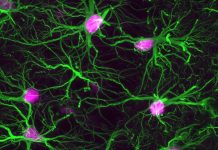
Researchers from the University of California, San Francisco (UCSF) have uncovered new insights into how Alzheimer’s disease spreads in the brain and why certain brain areas are more vulnerable than others.
Their study, published on July 9 in the journal Brain, combined brain scans, genetic data, and advanced computer modeling to explain the complex behavior of a protein called tau.
Tau is a protein that normally helps stabilize brain cells. But in Alzheimer’s disease, it becomes abnormal, forming tangled clumps inside brain cells.
These tau tangles damage the brain, disrupting how neurons work and eventually leading to cell death. Early in Alzheimer’s, areas like the hippocampus and entorhinal cortex are affected first, while other parts of the brain remain protected.
The new study helps explain why this happens. It introduces a powerful new computer model called the extended Network Diffusion Model (eNDM), which predicts how tau moves through the brain using data from healthy people’s brain connections—like a Google Maps for tau.
When researchers compared what the model predicted to what was actually seen in the brain scans of 196 people with Alzheimer’s, the differences pointed to the role of genes.
By using brain gene expression maps from the Allen Human Brain Atlas, the team discovered that some genes make certain areas more likely to be damaged, while others offer protection.
They identified four distinct types of genes: some promote the spread of tau along brain pathways, some increase tau buildup in specific spots regardless of brain wiring, others protect vulnerable regions along those pathways, and some provide protection in unexpected places.
Genes that made areas more vulnerable were linked to stress, metabolism, and cell death, while the protective genes were involved in the immune system and cleaning up harmful proteins like amyloid-beta, another key player in Alzheimer’s.
The findings build on earlier work from UCSF, published in May, which showed in mice that tau spreads through the brain by following its wiring—traveling along axons and not just leaking randomly. This discovery challenged the old belief that tau spreads passively between dying brain cells.
Lead researcher Dr. Ashish Raj explained that combining these tools—biology, genetics, and brain maps—can help scientists better understand how Alzheimer’s spreads and find new ways to stop it. “This study offers a hopeful map forward,” he said.
“It gives us better clues for targeting treatments and may eventually lead to new strategies to slow or prevent the disease.”
If you care about Alzheimer’s, please read studies about the likely cause of Alzheimer’s disease , and new non-drug treatment that could help prevent Alzheimer’s.
For more information about brain health, please see recent studies about diet that may help prevent Alzheimer’s, and results showing some dementia cases could be prevented by changing these 12 things.
The study is published in Brain.
Copyright © 2025 Knowridge Science Report. All rights reserved.



